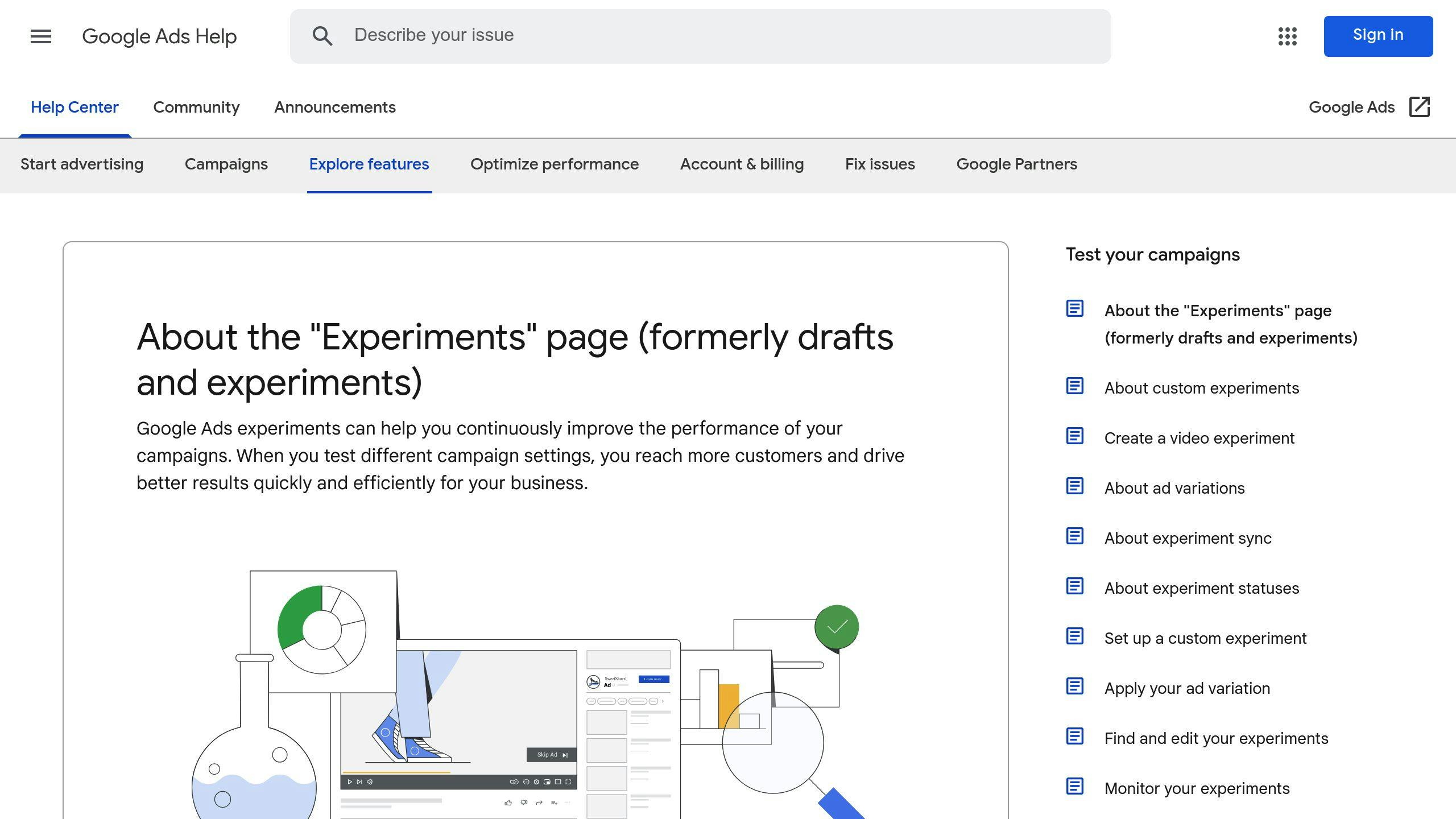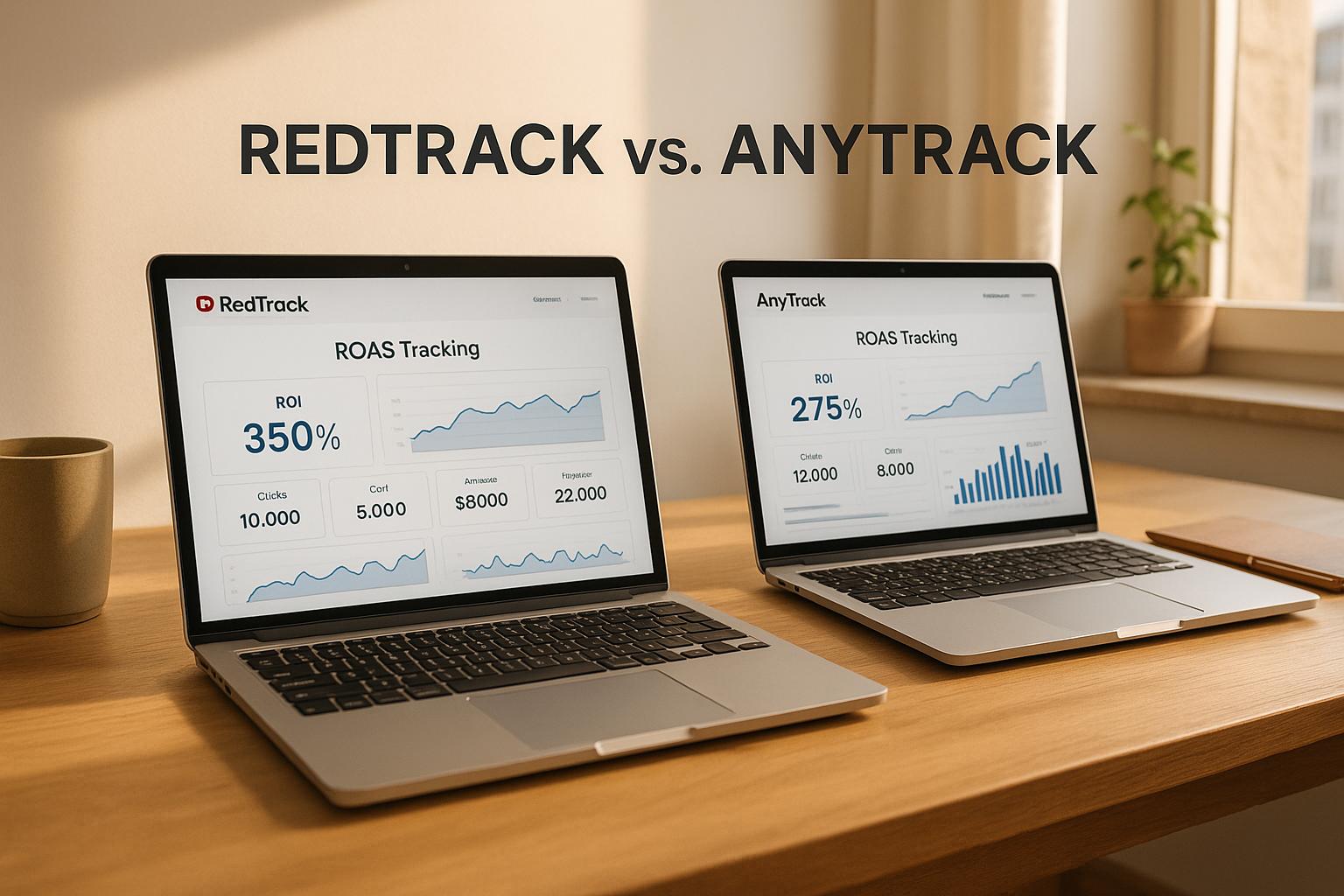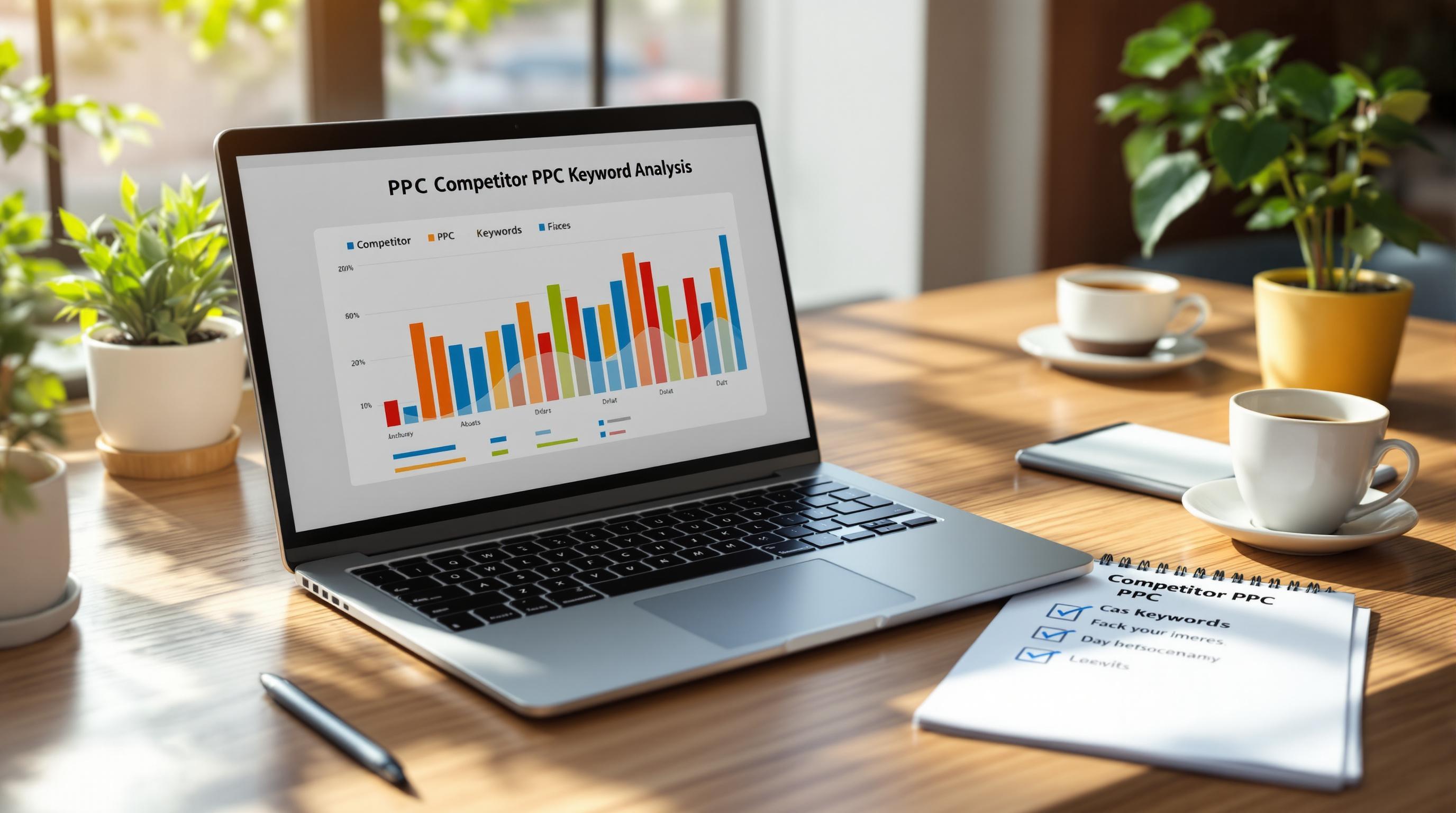Testing different PPC ad formats - like text, display, video, and shopping ads - can improve click-through rates (CTR), conversions, and cost efficiency. Here's how to do it:
- Set Clear Goals: Define measurable targets like "increase CTR by 25% in 60 days."
- Pick the Right Formats: Text ads for conversions, display for awareness, video for engagement, and shopping ads for e-commerce.
- A/B Test: Compare ad formats by keeping other variables constant.
- Track Key Metrics: Monitor CTR, conversion rate, CPA, and ROI.
- Test One Element at a Time: Focus on headlines, visuals, or CTAs individually.
- Collect Enough Data: Aim for 1,000–5,000 impressions per test.
- Account for Seasonal Changes: Adjust for holidays or industry trends.
- Test on Different Devices: Optimize for mobile, desktop, and tablet audiences.
- Refine Based on Results: Use data to improve performance step by step.
- Try Advanced Methods: Use multivariate testing or AI tools for deeper insights.
Quick Comparison of Ad Formats
| Ad Format | Best For | Key Considerations |
|---|---|---|
| Text Ads | Direct responses, sales | Ideal for high-intent searches and quick conversions. |
| Display Ads | Brand awareness | Great for visual impact and reaching broad audiences. |
| Video Ads | Storytelling, engagement | Requires more effort but connects emotionally. |
| Shopping Ads | E-commerce sales | Showcases product catalogs for direct purchases. |
| Responsive Search Ads | Multiple messages | Automatically adapts to user behavior. |
Start small, test systematically, and let the data guide your strategy. PPC testing is all about finding what works best for your audience and maximizing ROI.
Split Testing in Google Ads

1. Set Clear Goals for Testing
Having specific, measurable goals is the backbone of successful PPC ad format testing. Goals act as your guide, helping you decide which formats to test and which metrics to focus on. Avoid vague objectives like "improve performance." Instead, zero in on precise targets that directly influence your results.
For example, instead of saying "increase engagement", aim for something like: "Boost click-through rate by 25% within 60 days by testing different ad formats."
Here are some common PPC testing goals and metrics to track:
| Goal Type | Metric to Track | Example Target |
|---|---|---|
| Conversion Focus | Conversion Rate | Increase conversion rate by 1% |
| Efficiency | Cost Per Acquisition | Lower CPA by $10 |
| Engagement | Click-Through Rate | Improve CTR by 0.5% |
| Brand Impact | Impression Share | Raise impression share by 15% |
When setting goals, use your current data as a benchmark. For instance, if your text ads currently have a 2% CTR, aiming for a 10% CTR might not be realistic. Focus on smaller, achievable improvements based on past performance and industry trends.
Key Tips for Setting Goals
- Align goals with your overall campaign strategy and set clear deadlines.
- Track both primary metrics (like CTR) and supporting ones (like cost per click).
- Use tools from trusted PPC resources to simplify goal-setting and monitoring.
Once your goals are solid, the next step is figuring out which ad formats to test.
2. Pick the Right Ad Formats
Choosing the right ad formats can make or break your PPC testing efforts. Here's a quick rundown of the main PPC ad formats and when to use them:
| Ad Format | Best For | Key Considerations |
|---|---|---|
| Text Ads | Direct Response & Sales | Ideal for high-intent searches and campaigns focused on conversions. |
| Display Ads | Brand Awareness | Great for creating visual impact and reaching a broader audience. |
| Video Ads | Product Demonstrations | Perfect for engagement, storytelling, and building an emotional connection. |
| Shopping Ads | E-commerce Sales | Best for showcasing product catalogs and driving direct purchases. |
| Responsive Search Ads | Multiple Messages | Automatically tests different headlines and adapts to user behavior. |
How to Choose the Right Format
Think about your audience's habits and preferences. For instance, if your analytics reveal heavy mobile usage, go for mobile-friendly formats like responsive search ads. On the other hand, if you're targeting professionals during work hours, text ads might resonate more than video content.
Match Formats to Your Goals
Your ad format should align with what you're trying to achieve - whether it's boosting awareness or driving conversions. For example, you could test text ads for product searches alongside shopping ads that display product images and prices.
Keep an eye on critical metrics like clicks, conversions, and how ads perform across devices. This data will help you adjust your strategy and ensure your formats fit your budget.
For tools to simplify testing and track performance, check out platforms like the Top PPC Marketing Directory (ppcmarketinghub.com). Once you've nailed down the right formats, it's time to dive into A/B testing to see what works best.
3. Conduct A/B Testing
A/B testing helps you figure out which ad formats work best for your audience and align with your campaign objectives. It takes the guesswork out of improving performance by showing which variations deliver better results.
Setting Up Your Tests
When testing ad formats, keep everything else consistent - budget, targeting, schedule, keywords, and landing pages. This ensures you're isolating the impact of the ad format itself.
Testing Best Practices
Aim for results that are statistically reliable, with at least a 95% confidence level. Focus on key metrics like CTR (click-through rate), conversion rate, and profit per impression. Use your testing goals (from Section 1) to guide your analysis.
Using Google Ads Experiments

Google Ads Experiments lets you try out new ideas - like landing pages, ad extensions, or bidding strategies - without disrupting your live campaigns. This controlled environment makes it easier to measure the impact of changes.
Advanced Testing Methods
Performance Max campaigns are a great way to test how different ad formats work together across channels like Search, Display, Video, and Discovery. This approach gives you insight into how combined strategies affect your overall goals.
"Ad testing is especially important because your ad is the gateway standing between your potential customers and your website." - KlientBoost
Once your A/B tests are running, monitor performance metrics closely to identify top-performing formats and fine-tune your strategy.
4. Track Performance Metrics
Keeping an eye on performance metrics is crucial for testing and improving ad formats. These metrics provide the insights you need to make informed decisions.
Key Metrics to Watch
| Metric | What It Measures | Why It’s Important |
|---|---|---|
| Click-Through Rate (CTR) | How often people click on your ad | Indicates how relevant your ad is |
| Conversion Rate | How many users complete an action | Evaluates the success of the format |
| Cost Per Acquisition (CPA) | The cost of gaining a conversion | Helps manage your budget efficiently |
| Return on Investment (ROI) | Profitability of your campaign | Determines if your ads are worth the spend |
Using Analytics to Your Advantage
Connect tools like Google Ads and Google Analytics to track the full user journey - from the moment they see your ad to when they convert. This is especially useful during A/B testing, as it helps you pinpoint how different formats impact performance.
Make Regular Reviews a Habit
Set aside time to review your ad data on a consistent basis. Compare how different formats perform, look for trends or seasonal variations, and document your findings. This will provide a clear roadmap for future tests.
Organize and Analyze Like a Pro
Use ad labels in your advertising platform to keep your tests organized. For deeper analysis, pivot tables in Excel can be a game-changer for comparing formats and spotting patterns.
Once you’ve built a system for tracking and analyzing metrics, ensure you gather enough data before drawing any conclusions. This will help you make decisions that are both accurate and actionable.
5. Test One Element at a Time
When you focus on testing one variable at a time, it becomes easier to see how specific elements influence your results. This method gives you clear, actionable data to improve performance. Concentrate on individual components like ad copy, visuals, or extensions to pinpoint what works best.
Elements to Test Individually
| Element Type | Examples | Testing Approach |
|---|---|---|
| Ad Copy | Headlines, Descriptions | Experiment with different messages or tones |
| Visual Elements | Images, Videos, Colors | Test variations to see what drives engagement |
| Call-to-Action | Button Text, Placement | Try different phrases to boost conversions |
| Extensions | Sitelinks, Callouts | Assess their effect on click-through rates |
How to Run Tests
Start with a baseline ad and make one change - like tweaking the headline or call-to-action. Tools like Google Ads' Experiments and Drafts are perfect for this, as they let you test with precision and provide clear performance data.
Example: Testing Headlines
Let’s say you’re comparing two headlines: "Professional PPC Management" and "Maximize PPC Performance." Keep everything else in the ad the same. This way, you can see exactly how the headline influences results and use that insight to refine future campaigns.
Once you’ve tested individual elements, make sure to collect enough data to confidently draw conclusions and apply those learnings.
sbb-itb-89b8f36
6. Use Enough Data for Testing
Jumping to conclusions too quickly can lead to inaccurate insights. To avoid this, make sure you're collecting enough data for your tests to be reliable.
For dependable results, aim for 1,000–5,000 impressions per ad variation and a 95% confidence level. This helps ensure your findings are statistically sound and not just the result of random chance. This is especially important when running A/B tests to compare ad formats.
| Timeframe | Minimum Requirements | Purpose |
|---|---|---|
| Weekly Analysis | 5,000+ impressions | Identify trends |
| Campaign Testing | 2+ weeks runtime | Account for patterns |
Not gathering enough data can distort your results and waste your budget. Short testing periods may miss key influences like daily fluctuations, seasonal trends, or unexpected external events. To get reliable insights, extend your testing period and include a mix of data points, such as weekday and weekend performance.
| Factor | Impact | Solution |
|---|---|---|
| Daily Fluctuations | Can skew performance metrics | Include data from weekdays and weekends |
| External Events | May alter user behavior | Track events like holidays or major news |
Using a phased testing approach can help you refine your strategy. Start small to identify promising ad formats, then validate your findings with larger-scale tests. This methodical approach ensures your results hold up over time.
Once you've collected enough data, you can move on to analyzing how device types affect performance.
7. Account for Seasonal Changes
Seasonal shifts can have a big impact on PPC testing results. To get accurate insights, you need to tweak your strategies for busy shopping periods or slower times of the year. Testing ad formats during these seasons helps you align with changing audience behaviors.
Different times of the year can affect ad performance in surprising ways. For example, during Black Friday or Cyber Monday, competition heats up, driving CPCs higher. At the same time, conversion rates often improve because shoppers are ready to buy.
Here’s a quick look at how seasonal factors can influence your PPC testing:
| Season/Event | Impact | Adjustment |
|---|---|---|
| Holiday Season (Nov-Dec) | CPCs increase by 30-50% | Test 2-3 weeks before and 1-2 weeks after events |
| Back-to-School (Aug-Sep) | More mobile traffic | Focus on mobile-specific ad formats |
| Summer Slowdown (Jul-Aug) | Lower engagement rates | Adjust thresholds for significance |
| Major Industry Events | Traffic spikes | Exclude event dates from test data |
When testing during these seasonal periods, keep an eye on these factors:
- Ad rotation settings: Rotate ads frequently to quickly spot top performers.
- Device targeting: Mobile usage tends to spike during holidays and summer months.
- Geographic considerations: Seasonal weather can vary by region, influencing performance differently.
Leverage historical data from your Google Ads account to spot patterns specific to your industry. This helps you anticipate seasonal shifts and fine-tune your testing schedule.
Don’t forget to document external factors that might skew results. Tools like Google Trends can help you track seasonal patterns, providing context for year-over-year comparisons and better planning for future campaigns.
Next, let’s explore how ad formats perform across different devices.
8. Test Ads on Different Devices
Testing your ads across mobile, desktop, and tablet is key to understanding how they perform on each platform. Since user behavior varies depending on the device, this step can help you fine-tune your campaigns for better results.
Here’s a quick breakdown of how ad formats typically perform on different devices:
| Device Type | Best Performing Formats | Key Considerations |
|---|---|---|
| Mobile | Call-only ads, App install ads, Short video ads | Smaller screens, touch-based navigation |
| Desktop | Expanded text ads, Responsive display ads | More space for visuals and detailed content |
| Tablet | Image ads, Shopping ads | A mix of mobile and desktop behaviors |
To get the most out of your testing, keep an eye on metrics like CTR (often higher on mobile for certain industries), conversion rate (frequently stronger on desktop for high-value purchases), CPA (which can vary significantly by device), and ROAS (commonly higher on desktop for B2B campaigns).
Tips for Device-Specific Tests
Testing ads on all devices at the same time is important to avoid inconsistencies caused by timing. Adjust your approach for each device by focusing on these elements:
- Mobile: Use short headlines, simple CTAs, and add call or location extensions.
- Desktop: Include detailed headlines, rich descriptions, and all available ad extensions.
- Tablet: Strike a balance between mobile and desktop elements to cater to hybrid behavior.
When running these tests, consider:
- Adjusting bids based on device performance data.
- Monitoring performance at different times of day to spot trends.
- Tracking how each ad format resonates with the audience on specific devices.
- Analyzing user engagement patterns unique to each platform.
9. Refine Based on Test Results
Using test data to make meaningful improvements is a key step in running successful PPC campaigns. Here's how to adjust your ad formats effectively based on your findings.
Performance Analysis Framework
| Metric | What to Look For | What to Do |
|---|---|---|
| CTR | Patterns in specific formats | Focus on the best-performing ad types |
| Conversion Rate | Signals from user behavior | Adjust messaging and calls-to-action |
| ROI | Cost-effectiveness | Shift budget to the most effective ads |
| Quality Score | Indicators of relevance | Align ads more closely with keywords |
You’ll want to review test data from multiple angles. For instance, if responsive search ads have a 15% higher CTR but a 5% lower conversion rate compared to text ads, focus on improving conversion elements while keeping what makes the ads engaging.
Smart Refinement Strategies
Make changes based on clear, statistically meaningful results. Adjust one element at a time to understand what works. For example, if video ads are outperforming image ads, don’t overhaul everything at once. Instead:
- Pinpoint which video aspects (like length, tone, or message) are driving success.
- Apply those elements to other ad formats where possible.
- Track performance for at least two weeks before committing to permanent changes.
Pro Tip: Use your performance data to create a feedback loop. Regular adjustments ensure your campaigns stay aligned with the goals and metrics you set during testing.
Advanced Optimization Techniques
Leverage machine learning tools to identify winning combinations, scale successful elements, and anticipate trends. Platforms listed in the Top PPC Marketing Directory can help automate this process, saving you time.
Keep a record of the variables you test to decide which changes should stick and which might need further tweaking. Once your ad formats are fine-tuned, explore more advanced testing methods to push your campaigns even further.
10. Try Advanced Testing Methods
If you're ready to go beyond basic A/B testing, advanced methods can offer a deeper look into how your ads perform. Once you've nailed the basics, techniques like multivariate testing and AI-driven tools can help you find even more ways to optimize your campaigns.
Multivariate testing focuses on how different ad elements - like text, visuals, and audience targeting - work together. For example, you can test headlines, images, and audience segments all at once to discover the best combinations.
| Test Component | Variables to Test | Insights You Can Gain |
|---|---|---|
| Ad Copy | Headlines, descriptions, CTAs | Which messages engage your audience most |
| Visual Elements | Images, videos, layouts | Which visuals drive the most conversions |
| Targeting | Audience segments, placements | Best audience-creative pairings |
| Timing | Day parts, seasonal factors | When your ads perform best |
AI-Powered Optimization
AI tools, like Google Ads' automated bidding, are changing the game. For instance, automated bidding has been shown to boost conversions by 10% compared to manual methods. These tools analyze complex patterns in real time and adjust bids to maximize results.
Ensuring Reliable Results
For advanced testing to work, it's critical to maintain strict testing protocols. Run tests for at least 2-4 weeks (depending on your traffic) and ensure that your results are statistically valid. Skipping this step can lead to decisions based on faulty data.
Machine Learning in Testing
Platforms like Google Ads now incorporate machine learning to speed up testing and uncover valuable patterns. Google Ads Experiments, for instance, can test multiple ad variations across formats and placements, analyzing combinations like:
- Bidding strategies
- Audience targeting
- Ad format changes
- Landing page tweaks
If you're unsure where to start, consider checking out tools in the Top PPC Marketing Directory. Advanced testing methods can help you refine your strategy, discover what truly works, and stay ahead in the competitive PPC landscape.
Systematic PPC Ad Testing: Key Takeaways
Testing different PPC ad formats is crucial for improving campaign results and making the most of your budget. To succeed, you need clear objectives, smart format choices, and consistent A/B testing to gather actionable data.
The goal? Understand what works for your audience. A structured approach - testing, analyzing, and tweaking - lets you pinpoint the formats that deliver the best results for your market.
| Testing Phase | Focus Areas | What You Gain |
|---|---|---|
| Initial Setup | Define goals, choose formats | A clear plan and measurable benchmarks |
| Implementation | Run tests, collect data | Performance insights and valuable metrics |
| Optimization | Fine-tune, go advanced | Better-performing campaigns |
To make the process smoother, consider using analytics platforms and automation tools. Resources like the Top PPC Marketing Directory offer tools for managing campaigns, optimizing bids, and tracking performance - giving you an edge in your testing efforts.


